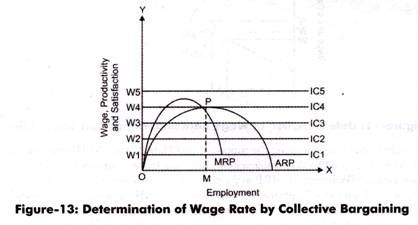Trade union gets existence under monopolistic competition. The trade union bargains with the employer on the issue of wage rate.
Generally, trade unions negotiate wages to be given to labor with employers.
This process of negotiating wages is called collective bargaining.
Figure-13 shows the determination of wage rate with the help of the collective bargaining process:
In Figure-13, ARP represents the average net revenue productivity curve and MRP represents marginal net revenue productivity curve. IC1, IC2, IC3, IC4, and IC5 show indifference curves at different wage rates with respect to the satisfaction of trade unions. It can be seen from Figure-13 that an increase in the wage rate would result in the increase of satisfaction level of trade unions.
In this case, trade union would prefer the wage rate at point P where indifference curve is tangent to ARP. At point P, the wage rate is OW4 and number of labor is OM. In case the wage rates goes up from OW4, then the employer would suffer losses and he/she needs to close his/her unit.
Therefore, it is not beneficial for the employer as well as for the union. This makes OW4 an upper limit for deciding on the wage rate. According to classical economists, the wage rate can be determined by market forces only and there is no contribution of trade unions in the increase of wages. If the trade unions try to increase the wage rate, the employers need to reduce the number of workers.
However, according to modem economists, trade unions contribute in raising wage rates by adopting the following measures:
ADVERTISEMENTS:
i. Helps in reducing labor exploitation by ensuring that the wage rates are equal to VMP. This can be done by increasing the bargaining power of labor by trade unions.
ii. Helps in increasing the MRP of labor through different ways, such as convincing employers to provide new and advanced machines to labor and inculcating the values of honesty and thrift among workers. Another way to increase MRP is by restricting the supply of labor.
iii. Reduces the supply of labor by convincing the government to pass immigration laws, reduce working hours, and limit the entry of labor in the trade union. This is done to increase wage rates.
iv. Helps in increasing the standard wage rates. If the standard wage rate increases, then it would automatically increases the wage rates of labor. This is a modern method adopted by trade unions for increasing the wage rate.
